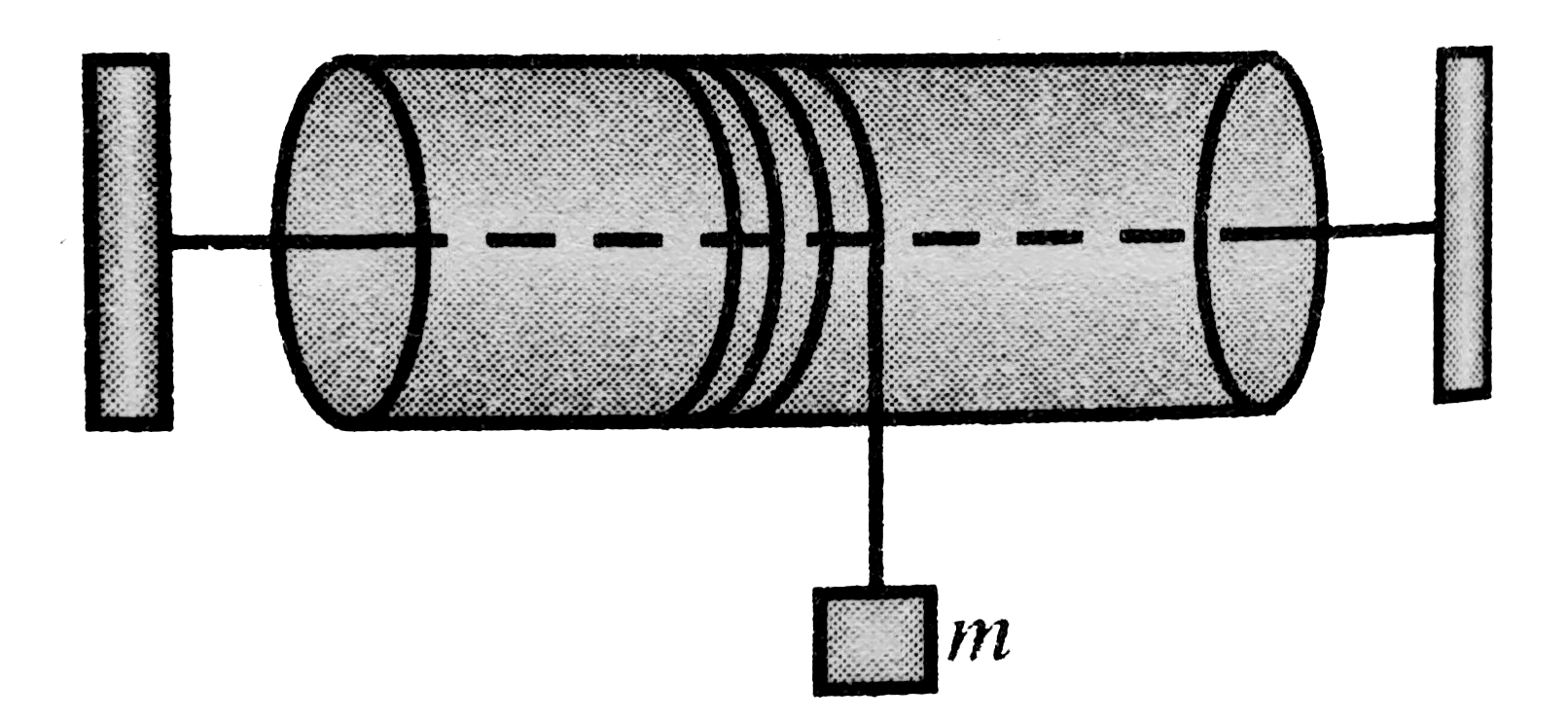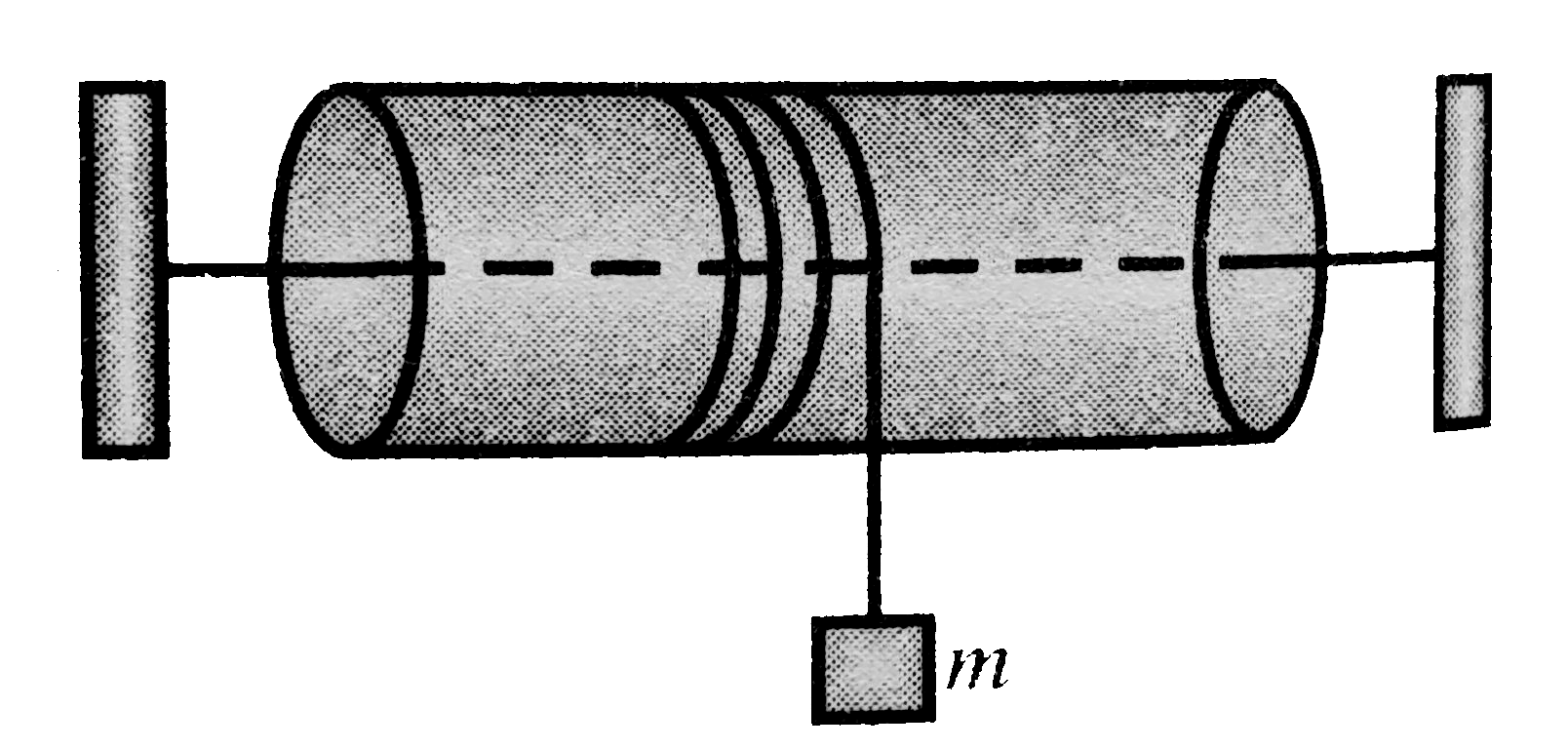A cord is wound around the circumference of a wheel of diameter 0.3 m. The axis of the wheel is horizontal. A mass of 0.5 kg is attached at the end of the cord and it is allowed to fall from rest. If the weight falls 1.5 m in 4s, what is the angular acceleration of the wheel ? Also find out the moment of inertia of the wheel.
To solve the problem step by step, we will follow these steps:
Step 1: Determine the acceleration of the falling mass
The mass falls a distance of 1.5 m in 4 seconds. We can use the equation of motion to find the acceleration (A).
Using the equation:
S=ut+12At2
where:
- S=1.5m (distance fallen)
- u=0m/s (initial velocity, since it starts from rest)
- t=4s
Substituting the values:
1.5=0+12A(42)
1.5=12A(16)
1.5=8A
A=1.58=0.1875m/s2
Step 2: Calculate the tension in the cord
Using Newton's second law for the falling mass (0.5 kg), we can find the tension (T) in the cord.
The forces acting on the mass are:
- Weight (mg) acting downwards: mg=0.5×9.81=4.905N
- Tension (T) acting upwards.
From Newton's second law:
mg−T=ma
Substituting the values:
4.905−T=0.5×0.1875
4.905−T=0.09375
T=4.905−0.09375=4.81125N
Step 3: Calculate the torque on the wheel
The torque (τ) acting on the wheel due to the tension in the cord is given by:
τ=T⋅r
where r is the radius of the wheel. The diameter of the wheel is 0.3 m, so the radius r=0.32=0.15m.
Substituting the values:
τ=4.81125⋅0.15=0.7216875N m
Step 4: Relate torque to angular acceleration
Using the relation between torque, moment of inertia (I), and angular acceleration (α):
τ=Iα
Step 5: Calculate the angular acceleration
We need to find the moment of inertia (I) first. For a wheel, we can assume it is a solid cylinder:
I=12mr2
Assuming m is the mass of the wheel, we will use the tension to find α directly.
From the torque equation:
α=τI
However, we need to find I first. Since we don't have the mass of the wheel, we can express I in terms of α.
Step 6: Find the moment of inertia
Using the relationship:
α=T⋅rI
We can rearrange to find I:
I=T⋅rα
Step 7: Calculate the angular acceleration
We can find α using:
α=τI
Substituting τ and r:
α=0.721687512⋅0.5⋅(0.152)
Final Calculation
Let's calculate I and α:
1. Calculate I:
I=12⋅0.5⋅(0.152)=12⋅0.5⋅0.0225=0.005625kg m2
2. Calculate α:
α=0.72168750.005625=128.5rad/s2
Final Answers
- The angular acceleration of the wheel is α≈128.5rad/s2.
- The moment of inertia of the wheel is I≈0.005625kg m2.
The mass falls a distance of 1.5 m in 4 seconds. We can use the equation of motion to find the acceleration (A).
S=ut+12At2
where:
- S=1.5m (distance fallen)
- u=0m/s (initial velocity, since it starts from rest)
- t=4s
1.5=0+12A(42)
1.5=12A(16)
1.5=8A
A=1.58=0.1875m/s2
Using Newton's second law for the falling mass (0.5 kg), we can find the tension (T) in the cord.
- Weight (mg) acting downwards: mg=0.5×9.81=4.905N
- Tension (T) acting upwards.
mg−T=ma
Substituting the values:
4.905−T=0.5×0.1875
4.905−T=0.09375
T=4.905−0.09375=4.81125N
The torque (τ) acting on the wheel due to the tension in the cord is given by:
τ=T⋅r
where r is the radius of the wheel. The diameter of the wheel is 0.3 m, so the radius r=0.32=0.15m.
τ=4.81125⋅0.15=0.7216875N m
Using the relation between torque, moment of inertia (I), and angular acceleration (α):
τ=Iα
We need to find the moment of inertia (I) first. For a wheel, we can assume it is a solid cylinder:
I=12mr2
Assuming m is the mass of the wheel, we will use the tension to find α directly.
α=τI
Using the relationship:
α=T⋅rI
We can rearrange to find I:
I=T⋅rα
We can find α using:
α=τI
Substituting τ and r:
α=0.721687512⋅0.5⋅(0.152)
Let's calculate I and α:
1. Calculate I:
I=12⋅0.5⋅(0.152)=12⋅0.5⋅0.0225=0.005625kg m2
α=0.72168750.005625=128.5rad/s2
- The angular acceleration of the wheel is α≈128.5rad/s2.
- The moment of inertia of the wheel is I≈0.005625kg m2.
Topper's Solved these Questions
- ROTATIONAL MOTIONBook:SL ARORAChapter:ROTATIONAL MOTIONExercise:Problem
Explore 24 Videos
- ROTATIONAL MOTIONBook:SL ARORAChapter:ROTATIONAL MOTIONExercise:Problem for self practice
Explore 90 Videos
- PROPERTIES OF SOLIDSBook:SL ARORAChapter:PROPERTIES OF SOLIDSExercise:All Questions
Explore 97 Videos
- System of particles & rotational MotionBook:SL ARORAChapter:System of particles & rotational MotionExercise:EXERCISE
Explore 353 Videos
Similar Questions
A cord is wound around the circumference of a bicycle wheel (without tyre) of diameter 1m. A mass of 2kg is tied at the end of the cord and it is allowed to fall from rest. The weight falls 2m in 4s. The axle of the wheel is horizontal and the wheel rotates which its plane vertical. if g=10ms−2, what is the angular acceleration of the wheel ?
View SolutionA cord of negligible mass is wound around the rim of a wheel of radius 20 cm. An object of mass 600 g is attached to the end of the cord and is allowed to fall from rest. It took 5 s for the object to fall by 2 m. Calculate the angular acceleration and moment of inertia of the wheel. Assume that the axis of wheel is horizontal.
View Solution
Knowledge Check
A cord is wound around the circumference of wheel of radius r. The axis of the wheel is horizontal and MI is I. A weight mg is attached to the end of the cord and falls from rest. After falling through a distance h, the angular velocity of the wheel will be
A√2ghI+mr2B(2mghI+mr2)1/2C(2mghI+2mr2)1/2D√2ghA cord is wound round the circumference of wheel of radius r. The axis of the wheel is horizontal and fixed and moment of inertia about it is I. A weight mg is attached to the end of the cord and falls from rest. After falling through a distance h, the angular velocity of the wheel will be.
A√2ghI+mrB√2mghI+mr2C√2mghI+2mr2D√2ghA cord is wound around the circumference of wheel of radius r the axis of the wheel is horizontal and moment of inerita about it is / The weight mg is attached to the end of the cord and falls from rest after falling throgh a distance h the angular velocity of the wheel will be
A[mgh]1/2B[2mghI+2mr2]1/2C[2mghI+mr2]1/2D[mghI+2mr2]1/2
A cord is wound round the circumference of a solid cylinder radius R and mass M. The axis of the cylinder is horizontal. A weight mg is attached to the end of the cord and falls from rest. After falling through a distance h.

View SolutionA cord is wound round the circumference of wheel of radius r. The axis of the wheel is horizontal and fixed and moment of inertia about it is I. A weight mg is attached to the end of the cord and falls from rest. After falling through a distance h, the angular velocity of the wheel will be.
View SolutionA cord is wound round the circumference of a wheel of radius r. The axis of the wheel is horizontal and its moment of inertia about this axis is I. A weight mg is attached to the end of the cord and is allowed to fall from rest. The angular velocity of the wheel, when the weight has fallen through a distance h, is
View SolutionA cord is wound round the circumference of wheel of radius r. The axis of the wheel is horizontal and the moment of inertia about it is I. A weight mg is attached to the cord at the end. The weight falls from rest. After falling through a distance 'h', the square of angular velocity of wheel will be :-
View SolutionA cord is wound round the circumference of a solid cylinder radius R and mass M. The axis of the cylinder is horizontal. A weight mg is attached to the end of the cord and falls from rest. After falling through a distance h.

If the mass starts from rest and falls a distance h, then its speed at that instant is:
View Solution

